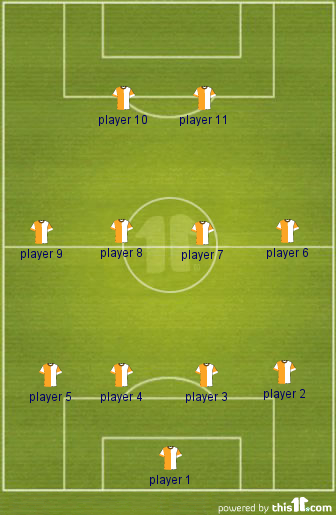With the announcement of the team news before the start of every game, the first reaction of a football fan is that they try and figure out the formation of the line up and indeed where in the formation each player is set to figure. The formation of the team and the opponents give a clear indication of not only the mindset of the teams but also an inkling of what to expect in the upcoming 90 minutes. For instance, often in big encounters between 2 fierce rivals, the 2 managers plump for the more conservative 4-5-1 formation and as a result the midfield gets crowded and the teams cancel each other out. Thus the formations employed by each team is integral tactically speaking to the game and is often a subject of intense debate.
Formations often come in and out of fashion and largely depend on the era of football and the formations being used by the most successful teams of the era. For example, fans of the Premier League and the English national team will no doubt be familiar with the 4-4-2 which employs 4 defenders, 4 midfielders and 2 strikers.
However in recent times, quite a few teams have been making the transition to the 4-2-3-1. This formation entails 4 defenders, 2 deep lying midfielders, 3 midfielders further up the field and 1 main striker.
This is one of my personal favourite formations and in my opinion is definitely preferable to the 4-4-2. The popularity of this formation is largely due to it’s compactness, fluidity and a direct result of the possession based football more and more modern day teams are striving towards. The points are further enumerated below:
- Defensive compactness
As shown in the image above, there are 2 holding midfielders namely players 5 and 6 who sit in front of the back 4. They not only serve as additional defensive cover but also are available to the defenders for a pass which leads to the team playing the ball out of defence often and not aimlessly punting the ball forward. Players in this position are normally good distributors of the ball and can set up quick counter attacks. Thus with this formation against say a 4-4-2 the tempo of the match could be controlled by the team playing the 4-2-3-1. In addition the 2 players also fill the holes created by the attacking fullback if they are caught on the break. While one could argue that the 2 central midfielders in a 4-4-2 could perform similar duties this would lead to the entire midfield dropping into a deeper position resulting in increased pressure on the defence and a higher likelihood of conceding a goal. We often see teams defending in 2 banks of 4 which is not conducive to attacking, entertaining football.
- Attacking fluidity
With the insurance of the back 4 and the 2 holding midfielders, the front 4 have more creative freedom to express themselves and play quality attacking football. Quite often in this system, each player in the top 4 can play in multiple positions which enables them to continuously interchange positions which makes it tougher for the opposition back 4 to mark specific players. This system also encourages quick intricate passing in the final third which is crucial to unlock crowded defences. With 4 attacking players teams are also better equipped to counter attack the opposition.
- Emphasis on the Number 10 or ‘Trequartista’
Number 10 or treqaurtista is the role assigned to a player who plays not as a traditional forward but ‘in the hole’ and has added creative freedom in the final third. Usually slight in build and technically adroit, they are known for the precision passing, ability to beat players, and eye for goal. The number 10s are not easy to defend against due to the simple fact that they operate between the traditional lines of midfield and defence. They act as the link between the midfield and the forward line. Most top European teams boast of their own ‘little genius’ and players in this position are fast becoming the most sought after in the transfer market.
- Death of old fashioned wing play and target men
The days of the old fashioned winger bombing down the wing, shifting the ball and getting a cross in at every opportunity is numbered. With few exceptions such as Antonio Valencia of Manchester United, this is a dying breed with managers preferring players who are comfortable on either foot and thus have equal tendencies of cutting infield or going around the full back and putting the ball into the box from out wide. The above traits can be seen in none other than Valencia’s club team mate Nani. Technically sound, the sight of Nani letting fly with his left foot after cutting in field is not uncommon for his regular watchers. This is also complemented with the use of attacking wing backs who are eager to join in with the attack and often provide an extra option on the overlap. This leads to a potential 2 on 1 situation against the opposing full back and could lead to a chance. This can be directly co-related to the first point where one of the holding midfielders can fill in for the full back. A lot of managers prefer playing a left footed player on the right wing and vice versa on the opposite wing. Thus a narrower 3 man line behind the striker is more preferable as opposed to the 2 traditional wingers who generally like to hug the touchline throughout the match. Old fashioned wingers are quite often synonymous with big target men in the box. Target men who like attacking the ball in the box and seem to be more comfortable with that than the ball being played to feet. While they are good options to have in your squad and can add an extra dimension to the attack if need be, they aren’t likely to figure in a 4-2-3-1.
- Shift of football style
With the Spanish national team and Barcelona winning trophies for fun at the moment, more teams are copying the style that has worked so well for them. The ‘tiki-taka’ philosophy certainly has it’s fair share of fans and rightly so. The possession based football employed by the Catalan club has been hugely effective. Although the formation commonly associated with it is the 4-3-3, the same game can be played using the 4-2-3-1 formation. Teams have started copying this style and most notably Swansea City, a newly promoted side won admirers on the way to a impressive 11th place in the Barclays Premier League.
- Fashionable
As teams gravitate towards the 4-2-3-1 system it is inevitable that more will follow. As I said in the beginning of my article, the popularity of a formation is dependent on the era and if teams employing the 4-2-3-1 achieve success, then it the dawn of the 4-2-3-1 as the most used formation could be upon us.
Credit: The images used are courtesy of this11.com
- Deconstructing the Perfect Counter-Attack - June 19, 2020
- The Battle For Indian Football’s Soul - May 19, 2020
- Bengaluru FC 2-1 FC Goa | Gritty Blues eke out an important win - January 6, 2020






























































